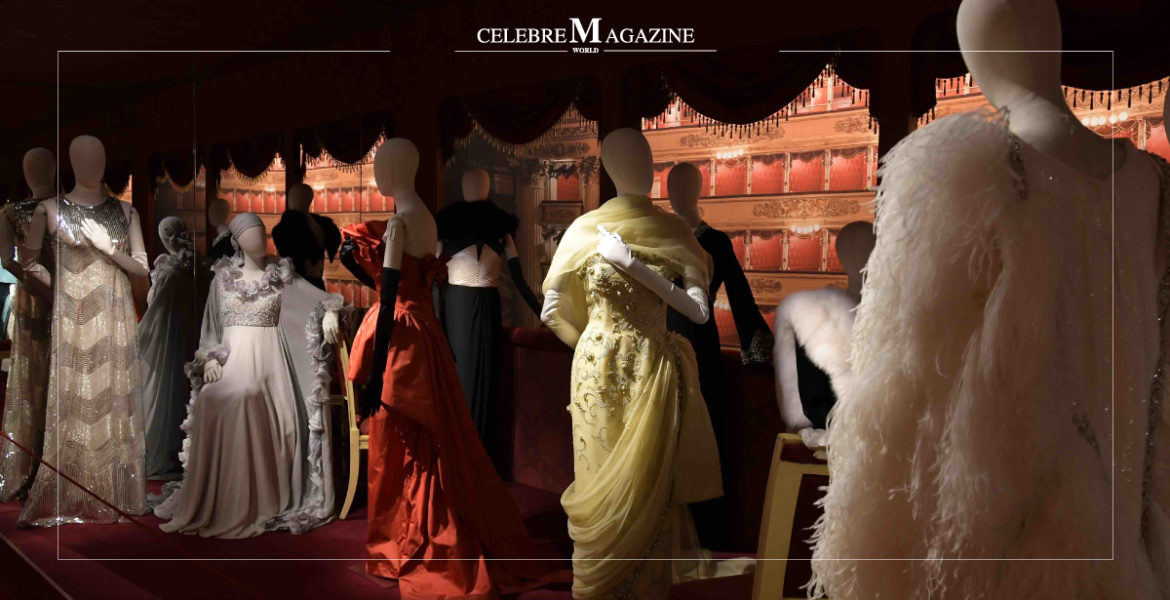Raffaella Curiel, Queen of Fashion, is the protagonist of La Scala Theatre Exhibition: «Nei palchi Della Scala – Storie Milanesi». The exhibition tells more than a century of Milan life and music through the stories of visitors to this historic theatre. It also exposed the clothes made by Italian designers.
First of all, I have to tell you something about this fantastic theatre. Teatro Alla Scala was founded, under the auspices of the Empress Maria Theresa of Austria, to replace the Royal Ducal Theatre, which was destroyed by fire on 26 February 1776 and had until then been the home of opera in Milan. Designed by the great neoclassical architect Giuseppe Piermarini, La Scala opened on 3 August 1778 with Antonio Salieri’s opera “L’Europa riconosciuta”.

But when you talk about Teatro Alla Scala you have to know also what Tosca is. Don’t worry, everything you need to know about Puccini’s Tosca is here. Tosca is a political thriller, set in Rome in June 1800 (during the Napoleonic wars and a time of great political unrest). The action takes place over less than 24 hours, making it an intense experience!
Scarpia has long lusted after Tosca, and when he suspects Cavaradossi of assisting an escaped political prisoner, seizes the opportunity to kill two birds with one stone. He will manipulate Tosca into revealing the prisoner’s hiding place and Cavaradossi’s involvement and have her for himself. When Cavaradossi is captured, Scarpia offers Tosca a horrific bargain, she must give herself to Scarpia, or her lover is killed. What will she choose? Who will survive?
I was very happy when I discovered that the exhibition “Nei palchi della storia – Storie milanesi”, curated by Pier Luigi Pizzi, opened its doors to the public .

The exhibition tells, more than a century of Milanese Theatre History, celebrating the stories of regulars visitors to Teatro Alla Scala. The history of great Milan families is then retraced, from Trivulzio to Litta, from Belgiojoso to Visconti. On the first floor, in fact, the exhibition opens with a double photographic representation of the evening gown dedicated by Raffaella Curiel, of which her family has worn most of the guests since the 1950s.
Born in 1943 near Trieste, Raffaella Curiel had fashion in her blood. Following her mother’s footsteps, Raffaella Curiel trained in the family atelier as well as in the Pierre Balmain French school, and in 1965 presented her first pret-à-porter collection in New York for Bergdorf Goodman. The exhibition also involves the visitor with the faces of Eugenio Montale, Carla Fracci and Valentina Cortese, Wally and Arturo Toscanini, Anna Crespi, Vittoria Crespi Morbio, Nandi Ostali and Liliana Segre.

Now I wrote some personal thought. I am going to start saying that I love my job and that it brings me great honour to be around artists like Raffaella Curiel. We decided to do shooting and to set an interview in one of the most beautiful and historical places, Teatro La Scala, where I was lucky enough to be wearing one of the most beautiful and unique dresses Curiel ever made. The central piece was a sculpture made for Raffaella Curiel by Mario Rosello in the ’80s, the main reason being that the Curiel, which is a true artist and genius of Alta Moda in Italy and not only, was the first designer ever to be combining art and fashion.
I also had the pleasure to see the wall representing the most iconic ladies in the history wearing the greatest designers‘s piece, ladies like: Giovanna Lomazzi, Anna Majani, Eletta Polvani, Nandi Ostali, Anna Casati Stampa di Soncino, Coco Sepe Invernizzi, Raffaela Curiel, Adriana Besozzi, Gioia Marchi, Elizabeth Taylor, Valentina Cortese, Claire De Dierieux, Begum Om Habibeh Aga Khan, Anna Cicogna, Ina Sotis, Valeria Moriconi, Enrica Invernizzi, Gigliola Curiel, Silvana Pampanini, Evelina Levi Broglio Shapira, Giovanna Bergonzoni Borletti Dell’Acqua, Marika Carniti Bollea, and my personal favorite one: Princess Grace of Monaco. The elegant ladies who adorn the walls of this room, all in evening dresses for the season-opening of December 7th, wore gown designed by great names of the ’50s, 60’s and ’70s, names such as Curiel, Valentino and Ungaro.

Pier Luigi Pizzi, curator of the exhibition, called this wall “Quarto stato delle dame“, which means “The fourth estate of the ladies“. In this magical place, Teatro alla Scala, there is also an exhibition of some of the most iconic dresses created and worn by names like: Gigliola Curiel, worn by Evelina Levi Broglio Shapira in 1965, the gown is made with velvet, pearls, canes and rhinestones. Sartoria Dragoni-Venezia, had three dresses exposed, all three worn by Nandi Ostali in 1957. The dress was made of silk satin and chiffon, embroidered with beads and canes. The second dress was worn in 1958 and it was made of macramé lace and cape in taffeta silk. The 3rd dress also worn in 1958, made of silk tulle with rhinestones. Yves Saint Laurent , worn by Lina Sotis in the 70’s. The dress was made of velours and silk crèpe.

Finally, I must say that I asked the designer Gigliola Curiel an opinion about how the dressing code is evolving when going to the theatre. She said: “You have to preserve traditions and going to a social event dressed like for a shopping day, as many people do today, it is not the best of Bon Ton… I find that elegance is an essential point; it is not a value to lose; the goal is to be elegant wearing a dress with attention to details, which becomes an important sign of respect for the work that will be seen. From the inspiring woman, this is the message to give to the new generations.“
by Maria Zota
photo by Nick Zonna



